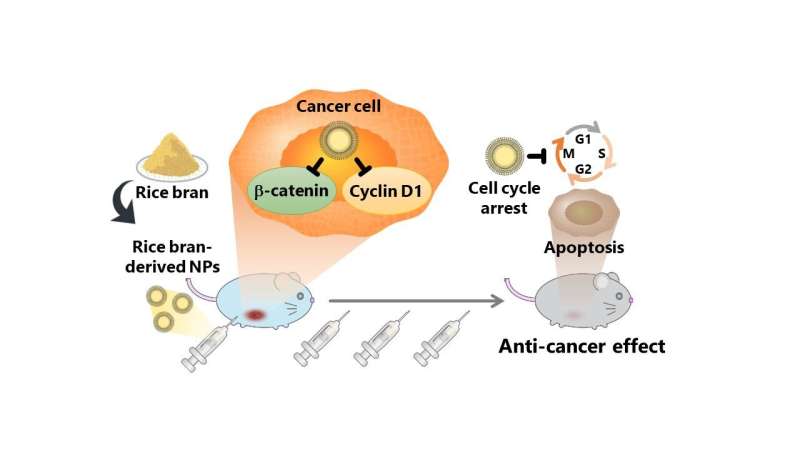This article has been reviewed according to Science X's editorial process and policies. Editors have highlighted the following attributes while ensuring the content's credibility:
fact-checked
trusted source
proofread
Rice bran nanoparticles show promise as affordable and targeted anticancer agent

Several types of conventional cancer therapies, such as radiotherapy or chemotherapy, destroy healthy cells along with cancer cells. In advanced stages of cancer, tissue loss from treatments can be substantial and even fatal. Cutting-edge cancer therapies that employ nanoparticles can specifically target cancer cells, sparing healthy tissue.
Recent studies have demonstrated that plant-derived nanoparticles (pdNPs) that have therapeutic effects can be an effective alternative to traditional cancer treatments. However, no pdNPs have been approved as anticancer therapeutic agents till date.
Rice bran is a byproduct generated during rice refining process that has limited utility and low commercial value. However, it contains several compounds with anticancer properties, such as γ-oryzanol and γ-tocotrienol.
To explore these therapeutic properties of rice bran, a team of researchers led by Professor Makiya Nishikawa from Tokyo University of Science (TUS) in Japan developed nanoparticles from rice bran and tested their effectiveness in mice models. Their study, published in the Journal of Nanobiotechnology on 16 March 2024, was co-authored by Dr. Daisuke Sasaki, Ms. Hinako Suzuki, Associate Professor Kosuke Kusamori, and Assistant Professor Shoko Itakura from TUS.
"In recent years, an increasing number of new drug modalities are being developed. At the same time, development costs associated with novel therapies have increased dramatically, contributing to the burden of medical expenses. To address this issue, we used rice bran, an industrial waste with anticancer properties, to develop nanoparticles," explains Prof. Nishikawa.
The study evaluated the anticancer effects of rice bran-derived nanoparticles (rbNPs), which were obtained by processing and purifying a suspension of Koshihikari rice bran in water. When a cancer cell line named colon26 was treated with rbNPs, cell division was arrested and programmed cell death was induced, indicating strong anticancer effects of the nanoparticles. The observed anticancer activity of rbNPs can be attributed to γ-tocotrienol and γ-oryzanol, that are easily taken up by cancer cells resulting in cell cycle arrest and programmed cell death.
Additionally, rbNPs reduced the expression of proteins, such as β-catenin (a protein associated with Wnt signaling pathway involved in cell proliferation) and cyclin D1, which are known to promote cancer recurrence and metastases. Moreover, the rbNPs reduced the expression of β-catenin only in colon26 cells without affecting the non-cancerous cells.
"A key concern in the context of pdNPs is their low pharmacological activity compared to pharmaceutical drugs. However, rbNPs exhibited higher anticancer activity than DOXIL, a liposomal pharmaceutical formulation of doxorubicin. Additionally, doxorubicin is cytotoxic to both cancer cells and non-cancerous cells, whereas rbNPs are specifically cytotoxic to cancer cells, suggesting that rbNPs are safer than doxorubicin," says Prof. Nishikawa.
To confirm the anticancer properties of rbNPs in the living body, the researchers injected rbNPs into mice having aggressive adenocarcinoma in their peritoneal cavity (enclosed by the diaphragm, abdominal muscles, and pelvis and houses organs like intestines, liver, and kidneys). They observed significant suppression of tumor growth with no adverse effects on the mice. Additionally, the rbNPs significantly inhibited metastatic growth of murine melanoma B16-BL6 cells in a lung metastasis mouse model.
Rice bran has several attributes that make it an excellent source of therapeutic pdNPs. Firstly, it is economic as compared to many other sources of pdNPs. Nearly 40% of the rice bran is discarded in Japan, providing a readily available source of raw material. Secondly, the preparation efficiency of rbNPs is higher than that of previously reported pdNPs.
Besides being practical and safe as an anticancer therapeutic, the physicochemical properties of rbNPs are very stable. However, a few parameters, such as establishment of separation technologies at the pharmaceutical level, assessing production process control parameters, and evaluation of efficacy and safety in human cancer cell lines and xenograft animal models, must be investigated prior to clinical trials in humans.
In conclusion, rice bran, an agricultural waste product, is a source of therapeutic pdNPs that are affordable, effective, and safe, and has the potential to revolutionize cancer treatment in the future.
"By establishing a manufacturing method for rice bran nanoparticles with stable quality and confirming their safety and effectiveness, we can develop drugs for cancer treatment that are sustainable, eco-friendly, and affordable. Consequently, we may be able to help more cancer patients maintain good physical and mental health after treatment," concludes Prof. Nishikawa.
More information: Daisuke Sasaki et al, Development of rice bran-derived nanoparticles with excellent anti-cancer activity and their application for peritoneal dissemination, Journal of Nanobiotechnology (2024). DOI: 10.1186/s12951-024-02381-z
Provided by Tokyo University of Science





















